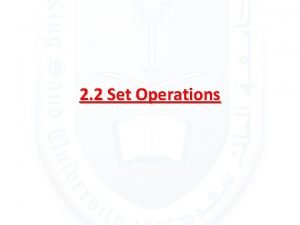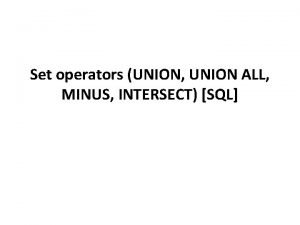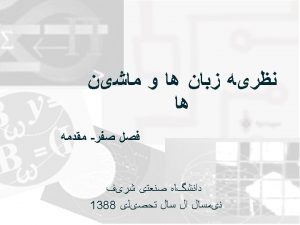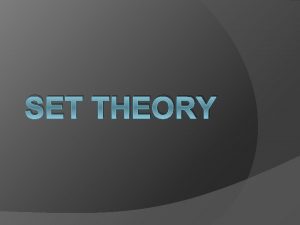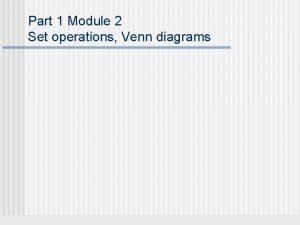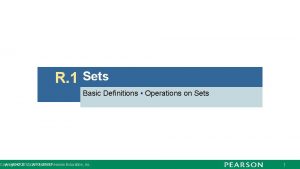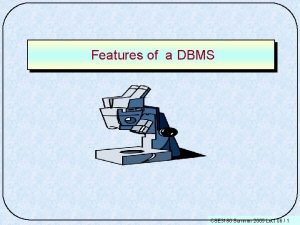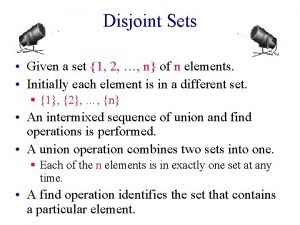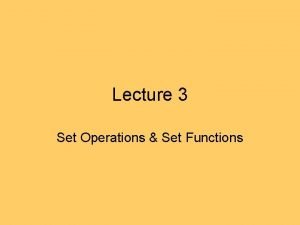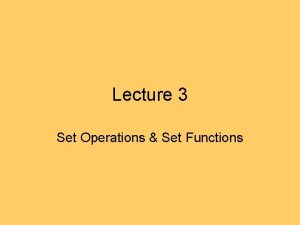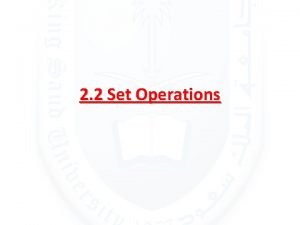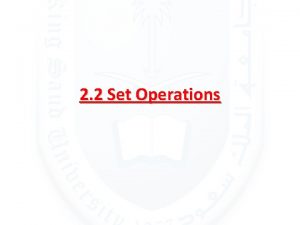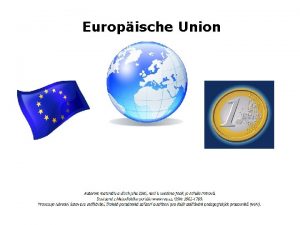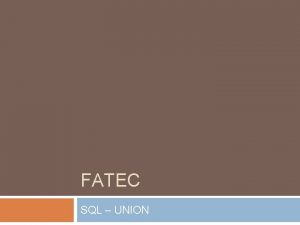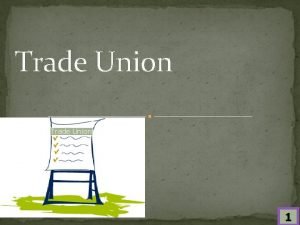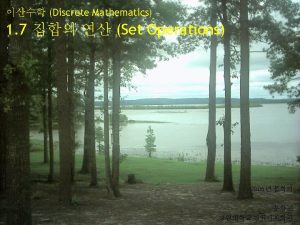2 2 Set Operations The Union DEFINITION 1
















- Slides: 16

2. 2 Set Operations

The Union DEFINITION 1 • Let A and B be sets. The union of the sets A and B , denoted by A U B , is the set that contains those elements that are either in A or in B , or in both. • An element x belongs to the union of the sets A and B if and only if x belongs to A or x belongs to B. • This tells us that A U B = {x | x ϵ A V x ϵ B }.

EXAMPLE 1 The union of the sets {1, 3, 5} and {1, 2, 3} is the set {1, 2, 3, 5} ; that is, {1, 3, 5} U {1, 2, 3} = {1, 2, 3, 5}.

The Intersection DEFINITION 2 Let A and B be sets. The intersection of the sets A and B , denoted by A ∩ B , is the set containing those elements in both A and B. • An element x belongs to the intersection of the sets A and B if and only if x belongs to A and x belongs to B. • This tells us that A ∩ B = {x | x ϵ A Λ x ϵ B }.

EXAMPLE 2 The intersection of the sets {1, 3, 5} and {1, 2, 3} is the set {1, 3} ; that is, {1, 3, 5} ∩ {1, 2, 3} = {1, 3}.

Disjoint Sets DEFINITION 3 Two sets are called disjoint if their intersection is the empty set. EXAMPLE 3 Let A = {1, 3, 5, 7, 9} and B = {2, 4, 6, 8 , 10}. Because A ∩ B = Ф, A and B are disjoint.

The Cardinality Of a Union Of Two Finite Sets Note that I A I + I B I counts each element that is in A but not in B or in B but not in A exactly once, and each element that is in both A and B exactly twice. Thus, if the number of elements that are in both A and B is subtracted from IAI+ IBI , elements in A∩B will be counted only once. Hence, I A U B I = I A I + I B I - I A ∩ B I. • The generalization of this result to unions of an arbitrary number of sets is called the principle of inclusion-exclusion.

The Difference Of Two Sets •


EXAMPLE 4 The difference of {1, 3, 5} and {1, 2, 3} is the set {5}; that is, {1, 3, 5} - {1, 2, 3} = {5}. Caution! This is different from the difference of {1, 2, 3} and {1, 3, 5} , which is the set {2}. {1, 2, 3}- {1, 3, 5} = {2}.

The Complement Of a Set DEFINITION 5 • Let U be the universal set. The complement of the set A , denoted by Ā , is the complement of A with respect to U. • In other words, the complement of the set A is Ā=U-A. • An element belongs to Ā if and only if x ɇ A. This tells us that Ā = {x | x ɇ A }.


Example 5 (3/136) Let A = {1, 2, 3, 4, 5} and B = {0, 3, 6}. Find c) A-B d) B-A Solution: c) A-B = d) B-A=

Remark: •

Set Identities

Home. Works Page 136/137 • 3 (a, b) • 4(c, d) • 14 • 19 • 25 (a, c) • 59
 Total set awareness set consideration set
Total set awareness set consideration set Training set validation set test set
Training set validation set test set Set union definition
Set union definition Union union all intersect
Union union all intersect Union set operation
Union set operation Sipser, m: introduction to the theory of computation
Sipser, m: introduction to the theory of computation What is improper subset with examples
What is improper subset with examples Shade a-b in a venn diagram
Shade a-b in a venn diagram R set operations
R set operations Traditional set operations in dbms
Traditional set operations in dbms Disjoint set adt
Disjoint set adt Bounded set vs centered set
Bounded set vs centered set Fuzzy logic
Fuzzy logic Crisp set vs fuzzy set
Crisp set vs fuzzy set Crisp set vs fuzzy set
Crisp set vs fuzzy set What is the overlap of data set 1 and data set 2?
What is the overlap of data set 1 and data set 2? Correspondence function examples
Correspondence function examples


